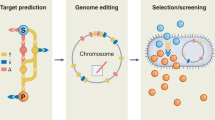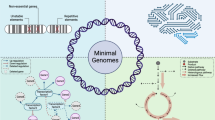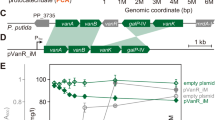Abstract
Engineering the synthesis of massive amounts of therapeutics, enzymes or commodity chemicals can select for subpopulations of nonproducer cells, owing to metabolic burden and product toxicity. Deep DNA sequencing can be used to detect undesirable genetic heterogeneity in producer populations and diagnose associated genetic error modes. Hotspots of genetic heterogeneity can pinpoint mechanisms that underlie load problems and product toxicity. Understanding genetic heterogeneity will inform metabolic engineering and synthetic biology strategies to minimize the emergence of nonproducer mutants in scaled-up fermentations and maximize product quality and yield.
This is a preview of subscription content, access via your institution
Access options
Access Nature and 54 other Nature Portfolio journals
Get Nature+, our best-value online-access subscription
$29.99 / 30 days
cancel any time
Subscribe to this journal
Receive 12 print issues and online access
$209.00 per year
only $17.42 per issue
Buy this article
- Purchase on Springer Link
- Instant access to full article PDF
Prices may be subject to local taxes which are calculated during checkout



Similar content being viewed by others
References
Glick, B. R. Metabolic load and heterologous gene expression. Biotechnol. Adv. 13, 247–261 (1995).
Nielsen, J. & Keasling, J. Engineering cellular metabolism. Cell 164, 1185–1197 (2016).
Lee, S. Y. & Kim, H. U. Systems strategies for developing industrial microbial strains. Nat. Biotechnol. 33, 1061–1072 (2015).
Van Dien, S. From the first drop to the first truckload: Commercialization of microbial processes for renewable chemicals. Curr. Opin. Biotechnol. 24, 1061–1068 (2013).
Burgard, A., Burk, M. J., Osterhout, R., Van Dien, S. & Yim, H. Development of a commercial scale process for production of 1,4-butanediol from sugar. Curr. Opin. Biotechnol. 42, 118–125 (2016).
Leavell, M. D., McPhee, D. J. & Paddon, C. J. Developing fermentative terpenoid production for commercial usage. Curr. Opin. Biotechnol. 37, 114–119 (2016).
Newbert, R. W., Barton, B., Greaves, P., Harper, J. & Turner, G. Analysis of a commercially improved Penicillium chrysogenum strain series: involvement of recombinogenic regions in amplification and deletion of the penicillin biosynthesis gene cluster. J. Ind. Microbiol. Biotechnol. 19, 18–27 (1997).
Azuma, T., Nakanishi, T. & Sugimoto, M. Isolation and characterization of a stable L-arginine producer from continuous culture broth of Corynebacterium acetoacidophilum. J. Ferment. Technol. 66, 279–284 (1988).
Harris, R. J. et al. Assessing genetic-heterogeneity in production cell lines: detection by peptide mapping of a low level Tyr to Gln sequence variant in a recombinant antibody. Nat. Biotechnol. 11, 1293–1297 (1993).
Zelder, O. & Hauer, B. Environmentally directed mutations and their impact on industrial biotransformation and fermentation processes. Curr. Opin. Microbiol. 3, 248–251 (2000).
Rugbjerg, P., Myling-Petersen, N., Porse, A., Sarup-Lytzen, K. & Sommer, M. O. A. Diverse genetic error modes constrain large-scale bio-based production. Nat. Commun. 9, 787 (2018).
Xiao, Y., Bowen, C. H., Liu, D. & Zhang, F. Exploiting nongenetic cell-to-cell variation for enhanced biosynthesis. Nat. Chem. Biol. 12, 339–344 (2016).
Rugbjerg, P., Sarup-Lytzen, K., Nagy, M. & Sommer, M. O. A. Synthetic addiction extends the productive life time of engineered Escherichia coli populations. Proc. Natl Acad. Sci. 115, 2347–2352 (2018).
Gupta, A., Reizman, I. M. B., Reisch, C. R. & Prather, K. L. J. Dynamic regulation of metabolic flux in engineered bacteria using a pathway-independent quorum-sensing circuit. Nat. Biotechnol. 35, 273–279 (2017).
Ceroni, F. et al. Burden-driven feedback control of gene expression. Nat. Methods 15, 387–393 (2018).
Yano, H. et al. Evolved plasmid-host interactions reduce plasmid interference cost. Mol. Microbiol. 101, 743–756 (2016).
Karim, A. S., Curran, K. A. & Alper, H. S. Characterization of plasmid burden and copy number in Saccharomyces cerevisiae for optimization of metabolic engineering applications. FEMS Yeast Res. 13, 107–116 (2012).
Bentley, W. E., Mirjalili, N., Andersen, D. C., Davis, R. H. & Kompala, D. S. Plasmid-encoded protein: The principal factor in the ‘metabolic burden’ associated with recombinant bacteria. Biotechnol. Bioeng. 35, 668–681 (1990).
Kafri, M., Metzl-Raz, E., Jona, G. & Barkai, N. The cost of protein production. Cell Rep. 14, 22–31 (2016).
Klein, T. et al. Overcoming the metabolic burden of protein secretion in Schizosaccharomyces pombe - A quantitative approach using 13C-based metabolic flux analysis. Metab. Eng. 21, 34–45 (2014).
Villaverde, A. & Carrió, M. M. Protein aggregation in recombinant bacteria: biological role of inclusion bodies. Biotechnol. Lett. 25, 1385–95 (2003).
Geiler-Samerotte, K. A. et al. Misfolded proteins impose a dosage-dependent fitness cost and trigger a cytosolic unfolded protein response in yeast. Proc. Natl Acad. Sci. 108, 680–685 (2011).
Kwon, S. K., Kim, S. K., Lee, D. H. & Kim, J. F. Comparative genomics and experimental evolution of Escherichia coli BL21(DE3) strains reveal the landscape of toxicity escape from membrane protein overproduction. Sci. Rep. 5, 16076 (2015).
Nielsen, A. A. K. et al. Genetic circuit design automation. Science 352, aac7341–aac7341 (2016).
Pitera, D. J., Paddon, C. J., Newman, J. D. & Keasling, J. D. Balancing a heterologous mevalonate pathway for improved isoprenoid production in Escherichia coli. Metab. Eng. 9, 193–207 (2007).
Kazemi Seresht, A. et al. Long-term adaptation of Saccharomyces cerevisiae to the burden of recombinant insulin production. Biotechnol. Bioeng. 110, 2749–2763 (2013).
Michener, J. K., Nielsen, J. & Smolke, C. D. Identification and treatment of heme depletion attributed to overexpression of a lineage of evolved P450 monooxygenases. Proc. Natl Acad. Sci. USA 109, 19504–19509 (2012).
Carneiro, S., Ferreira, E. C. & Rocha, I. Metabolic responses to recombinant bioprocesses in Escherichia coli. J. Biotechnol. 164, 396–408 (2013).
Wu, G. et al. Metabolic burden: cornerstones in synthetic biology and metabolic engineering applications. Trends Biotechnol. 34, 652–664 (2016).
Linster, C. L., Van Schaftingen, E. & Hanson, A. D. Metabolite damage and its repair or pre-emption. Nat. Chem. Biol. 9, 72–80 (2013).
Zhu, M. M., Skraly, Fa & Cameron, D. C. Accumulation of methylglyoxal in anaerobically grown Escherichia coli and its detoxification by expression of the Pseudomonas putida glyoxalase I gene. Metab. Eng. 3, 218–225 (2001).
Tuite, N. L., Fraser, K. R. & Byrne, C. P. O. Homocysteine toxicity in Escherichia coli is caused by a perturbation of branched-chain amino acid biosynthesis. J. Bacteriol. 187, 4362–4371 (2005).
Kizer, L., Pitera, D. J., Pfleger, B. F. & Keasling, J. D. Application of functional genomics to pathway optimization for increased isoprenoid production. Appl. Environ. Microbiol. 74, 3229–41 (2008).
Tindall, K. R. & Stankowski, L. F. Molecular analysis of spontaneous mutations at the gpt locus in Chinese hamster ovary (AS52) cells. Mutat. Res. Genet. Toxicol. 220, 241–253 (1989).
Zhang, Z., Shah, B. & Bondarenko, P. V. G/U and certain wobble position mismatches as possible main causes of amino acid misincorporations. Biochemistry 52, 8165–8176 (2013).
Cartwright, J. F., Anderson, K., Longworth, J., Lobb, P. & James, D. C. Highly sensitive detection of mutations in CHO cell recombinant DNA using multi-parallel single molecule real-time DNA sequencing. Biotechnol. Bioeng. 115, 1485–1498 (2018).
Zeck, A. et al. Low level sequence variant analysis of recombinant proteins: An optimized approach. PLoS One 7, e40328 (2012).
Lee, H., Popodi, E., Tang, H. & Foster, P. L. PNAS Plus: Rate and molecular spectrum of spontaneous mutations in the bacterium Escherichia coli as determined by whole-genome sequencing. Proc. Natl Acad. Sci. 109, E2774–E2783 (2012).
Renda, B. A., Hammerling, M. J. & Barrick, J. E. Engineering reduced evolutionary potential for synthetic biology. Mol. BioSyst. 10, 1668–1678 (2014).
Moxon, R., Bayliss, C. & Hood, D. Bacterial contingency loci: the role of simple sequence dna repeats in bacterial adaptation. Annu. Rev. Genet. 40, 307–333 (2006).
Beekwilder, J. et al. Polycistronic expression of a β-carotene biosynthetic pathway in Saccharomyces cerevisiae coupled to β-ionone production. J. Biotechnol. 192, 383–392 (2014).
Yoshikawa, T. et al. Amplified gene location in chromosomal dna affected recombinant protein production and stability of amplified genes. Biotechnol. Prog. 16, 710–715 (2000).
Schlegel, S., Genevaux, P. & de Gier, J. W. De-convoluting the genetic adaptations of E. coli C41(DE3) in real time reveals how alleviating protein production stress improves yields. Cell Rep. 10, 1758–1766 (2015).
Lovett, S. T., Hurley, R. L., Sutera, V. A., Aubuchon, R. H. & Lebedeva, M. A. Crossing over between regions of limited homology in Escherichia coli. RecA-dependent and RecA-independent pathways. Genetics 160, 851–859 (2002).
Jinks-Robertson, S. & Bhagwat, A. S. Transcription-associated mutagenesis. Annu. Rev. Genet. 48, 341–359 (2014).
Bzymek, M. & Lovett, S. T. Instability of repetitive DNA sequences: The role of replication in multiple mechanisms. Proc. Natl Acad. Sci. USA 98, 8319–8325 (2001).
Mahillon, J. & Chandler, M. Insertion sequences. Microbiol. Mol. Biol. Rev. 62, 725–774 (1998).
Richardson, S. M. et al. Design of a synthetic yeast genome. Science 355, 1040–1044 (2017).
Xu, X. et al. The genomic sequence of the Chinese hamster ovary (CHO)-K1 cell line. Nat. Biotechnol. 29, 735–41 (2011).
Kim, J. Y., Kim, Y. & Lee, G. M. CHO cells in biotechnology for production of recombinant proteins: current state and further potential. Appl. Microbiol. Biotechnol. 93, 917–930 (2012).
Kroll, J., Klinter, S., Schneider, C., Voß, I. & Steinbüchel, A. Plasmid addiction systems: Perspectives and applications in biotechnology. Microb. Biotechnol. 3, 634–657 (2010).
Scholes, D. T., Banerjee, M., Bowen, B. & Curcio, M. J. Multiple regulators of Ty1 transposition in Saccharomyces cerevisiae have conserved roles in genome maintenance. Genetics 159, 1449–1465 (2001).
Fahnert, B., Lilie, H. & Neubauer, P. Inclusion bodies: formation and utilisation. in Physiological Stress Responses in Bioprocesses. Advances in Biochemical Engineering 89, 93–142 (Springer, 2004).
Hoffmann, F. & Rinas, U. Stress induced by recombinant protein production in Escherichia coli. in Physiological Stress Responses in Bioprocesses 89, 73–92 (Springer, 2004).
Tippin, B., Pham, P. & Goodman, M. F. Error-prone replication for better or worse. Trends Microbiol. 12, 288–295 (2004).
Foster, P.L. Stress-induced mutagenesis in bacteria. in Critical Reviews in Biochemistry and Molecular Biology 42, 373–397 (Springer, 2007).
Bailey, L. A., Hatton, D., Field, R. & Dickson, A. J. Determination of Chinese hamster ovary cell line stability and recombinant antibody expression during long-term culture. Biotechnol. Bioeng. 109, 2093–2103 (2012).
International Conference on Harmonisation & FDA. Guidance on quality of biotechnological/biological products: Derivation and characterization of cell substrates used for production of biotechnological/biological products. US Fed. Regist. 63, 50244–50249 (1998).
Mercier, S. M., Diepenbroek, B., Wijffels, R. H. & Streefland, M. Multivariate PAT solutions for biopharmaceutical cultivation : current progress and limitations. Trends Biotechnol. 32, 329–336 (2014).
Yusufi, F. N. K. et al. Mammalian systems biotechnology reveals global cellular adaptations in a recombinant CHO cell line. Cell Syst. 4, 530–542.e6 (2017).
Nakamura, K. et al. Sequence-specific error profile of Illumina sequencers. Nucleic Acids Res. 39, e90 (2011).
Salk, J. J., Schmitt, M. W. & Loeb, L. A. Enhancing the accuracy of next-generation sequencing for detecting rare and subclonal mutations. Nat. Rev. Genet. 19, 269–285 (2018).
Deatherage, D. E., Traverse, C. C., Wolf, L. N. & Barrick, J. E. Detecting rare structural variation in evolving microbial populations from new sequence junctions using breseq. Front. Genet. 5, 1–16 (2015).
Rehder, D. S. et al. Expression vector-derived heterogeneity in a therapeutic IgG4 monoclonal antibody. MAbs 11, 145–152 (2019).
Harris, R. P. & Kilby, P. M. Amino acid misincorporation in recombinant biopharmaceutical products. Curr. Opin. Biotechnol. 30, 45–50 (2014).
Dorai, H. et al. Early prediction of instability of chinese hamster ovary cell lines expressing recombinant antibodies and antibody-fusion proteins. Biotechnol. Bioeng. 109, 1016–1030 (2012).
Csorgo, B., Feher, T., Timar, E., Blattner, F. R. & Posfai, G. Low-mutation-rate, reduced-genome Escherichia coli: An improved host for faithful maintenance of engineered genetic constructs. Microb. Cell Fact. 11, 11 (2012).
Choi, J. W., Yim, S. S., Kim, M. J. & Jeong, K. J. Enhanced production of recombinant proteins with Corynebacterium glutamicum by deletion of insertion sequences (IS elements). Microb. Cell Fact. 14, 207 (2015).
Nyerges, Á. et al. CRISPR-interference based modulation of mobile genetic elements in bacteria. Synth. Biol. 4, ysz008 (2019).
Deatherage, D. E., Leon, D., Rodriguez, Á. E., Omar, S. K. & Barrick, J. E. Directed evolution of Escherichia coli with lower-than-natural plasmid mutation rates. Nucleic Acids Res. 46, 9236–9250 (2018).
Mikkelsen, M. D. et al. Microbial production of indolylglucosinolate through engineering of a multi-gene pathway in a versatile yeast expression platform. Metab. Eng. 14, 104–111 (2012).
Peng, B., Wood, R. J., Nielsen, L. K. & Vickers, C. E. An expanded heterologous GAL promoter collection for diauxie-inducible expression in Saccharomyces cerevisiae. ACS Synth. Biol. 7, 748–751 (2018).
Rugbjerg, P., Knuf, C., Förster, J. & Sommer, M. O. A. Recombination-stable multimeric green fluorescent protein for characterization of weak promoter outputs in Saccharomyces cerevisiae. FEMS Yeast Res. 15, fov085 (2015).
Kaas, C. S., Kristensen, C., Betenbaugh, M. J. & Andersen, M. R. Sequencing the CHO DXB11 genome reveals regional variations in genomic stability and haploidy. BMC Genomics 16, 160 (2015).
Zhang, H. & Wang, X. Modular co-culture engineering, a new approach for metabolic engineering. Metab. Eng. 37, 114–121 (2016).
Frumkin, I. et al. Gene architectures that minimize cost of gene expression. Mol. Cell 65, 142–153 (2017).
Sørensen, H. P. & Mortensen, K. K. Soluble expression of recombinant proteins in the cytoplasm of Escherichia coli. Microb. Cell Fact. 4, 1 (2005).
Xia, X.-X. et al. Native-sized recombinant spider silk protein produced in metabolically engineered Escherichia coli results in a strong fiber. Proc. Natl Acad. Sci. USA 107, 14059–14063 (2010).
Yu, T. et al. Reprogramming yeast metabolism from alcoholic fermentation to lipogenesis. Cell 174, 1549–1558.e14 (2018).
Erb, T. J., Jones, P. R. & Bar-Even, A. Synthetic metabolism: metabolic engineering meets enzyme design. Curr. Opin. Chem. Biol. 37, 56–62 (2017).
Genee, H. J. et al. Functional mining of transporters using synthetic selections. Nat. Chem. Biol. 12, 1015–1022 (2016).
Hansen, E. H. et al. De novo biosynthesis of vanillin in fission yeast (Schizosaccharomyces pombe) and baker’s yeast (Saccharomyces cerevisiae). Appl. Environ. Microbiol. 75, 2765–2774 (2009).
Venayak, N., Anesiadis, N., Cluett, W. R. & Mahadevan, R. Engineering metabolism through dynamic control. Curr. Opin. Biotechnol. 34, 142–152 (2015).
Studier, F. W. Protein production by auto-induction in high density shaking cultures. Protein Expr. Purif. 41, 207–234 (2005).
Figge, R. & Vasseur, P. Use of inducible promoters in the production of methionine. EP2513322A1 (2018).
Xu, P. Production of chemicals using dynamic control of metabolic fluxes. Curr. Opin. Biotechnol. 53, 12–19 (2018).
Dahl, R. H. et al. Engineering dynamic pathway regulation using stress-response promoters. Nat. Biotechnol. 31, 1039–46 (2013).
Taylor, N. D. et al. Engineering an allosteric transcription factor to respond to new ligands. Nat. Methods 13, 177–183 (2016).
Paddon, C. J. & Keasling, J. D. Semi-synthetic artemisinin: A model for the use of synthetic biology in pharmaceutical development. Nat. Rev. Microbiol. 12, 355–367 (2014).
Pitera, D.J., Newman, J.D., Kizer, J.L., Keasling, J.D. & Pfleger, B.F. Methods for increasing isoprenoid and isoprenoid precursor production by modulating fatty acid levels. US 8114645 B2 (2012).
Sandoval, C. M. et al. Use of pantothenate as a metabolic switch increases the genetic stability of farnesene producing Saccharomyces cerevisiae. Metab. Eng. 25, 215–226 (2014).
Halls, C. & Yu, O. Potential for metabolic engineering of resveratrol biosynthesis. Trends Biotechnol. 26, 77–81 (2008).
Reyes, L. H., Almario, M. P., Winkler, J., Orozco, M. M. & Kao, K. C. Visualizing evolution in real time to determine the molecular mechanisms of n-butanol tolerance in Escherichia coli. Metab. Eng. 14, 579–590 (2012).
Ro, D. K. et al. Induction of multiple pleiotropic drug resistance genes in yeast engineered to produce an increased level of anti-malarial drug precursor, artemisinic acid. BMC Biotechnol. 8, 1–14 (2008).
Mundhada, H. et al. Increased production of L-serine in Escherichia coli through adaptive laboratory evolution. Metab. Eng. 39, 141–150 (2017).
Koffas, M. A. G., Jung, G. Y. & Stephanopoulos, G. Engineering metabolism and product formation in Corynebacterium glutamicum by coordinated gene overexpression. Metab. Eng. 5, 32–41 (2003).
Raab, A. M., Gebhardt, G., Bolotina, N., Weuster-Botz, D. & Lang, C. Metabolic engineering of Saccharomyces cerevisiae for the biotechnological production of succinic acid. Metab. Eng. 12, 518–525 (2010).
Durfee, T. et al. The Complete genome sequence of Escherichia coli DH10B: Insights into the biology of a laboratory workhorse. J. Bacteriol. 190, 2597–2606 (2008).
Serero, A., Jubin, C., Loeillet, S., Legoix-Né, P. & Nicolas, A. G. Mutational landscape of yeast mutator strains. Proc. Natl Acad. Sci. USA 111, 1897–1902 (2014).
Summers, D. K. The kinetics of plasmid loss. Trends Biotechnol. 9, 273–8 (1991).
Acknowledgements
We thank A. Porse, F. Lino and C. Hjort for helpful comments. The research leading to these results has received funding from the Novo Nordisk Foundation, Denmark, grant number NNF10CC1016517, and from the European Union Seventh Framework Programme (FP7-KBBE-2013-7-single-stage) under grant agreement 613745, Promys.
Author information
Authors and Affiliations
Contributions
P.R. and M.O.A.S. outlined and wrote the manuscript.
Corresponding author
Ethics declarations
Competing interests
P.R. and M.O.A.S. are inventors of a pending patent application (WO2017055360) within product addiction filed by the Technical University of Denmark.
Additional information
Peer review information: Andy Marshall was the primary editor on this article and managed its editorial process and peer review in collaboration with the rest of the editorial team.
Publisher’s note: Springer Nature remains neutral with regard to jurisdictional claims in published maps and institutional affiliations.
Rights and permissions
About this article
Cite this article
Rugbjerg, P., Sommer, M.O.A. Overcoming genetic heterogeneity in industrial fermentations. Nat Biotechnol 37, 869–876 (2019). https://doi.org/10.1038/s41587-019-0171-6
Received:
Accepted:
Published:
Issue Date:
DOI: https://doi.org/10.1038/s41587-019-0171-6
This article is cited by
-
“Metabolic burden” explained: stress symptoms and its related responses induced by (over)expression of (heterologous) proteins in Escherichia coli
Microbial Cell Factories (2024)
-
Modelling genetic stability in engineered cell populations
Nature Communications (2023)
-
Biosensor-based high-throughput screening enabled efficient adipic acid production
Applied Microbiology and Biotechnology (2023)
-
Strategies for efficient production of recombinant proteins in Escherichia coli: alleviating the host burden and enhancing protein activity
Microbial Cell Factories (2022)
-
Enhancing bioreactor arrays for automated measurements and reactive control with ReacSight
Nature Communications (2022)



